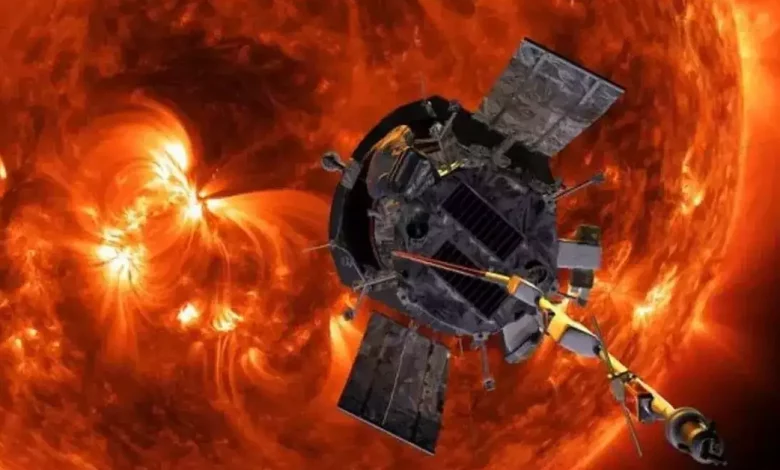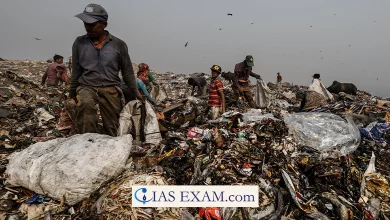Daily Current Affairs for UPSC
Aditya-L1 captures first glimpse of solar flares
Syllabus- Space Technology [GS Paper-3]

Context- The High Energy L1 orbiting X-ray spectrometer (HEL1OS) payload on the Aditya-L1 spacecraft captured the first glimpse of solar flares.
Key Highlights
- India’s first space-based solar probe, Aditya-L1, is currently on its way to the Sun-Earth L1 point (L1) and is expected to reach the L1 point in January 2024 when the satellite spends time mission life orbits L1 in an irregularly shaped orbit.
- L1 is about 1.5 million kilometers from Earth.
- Project Aditya-1 was initially proposed as a 400 kg class satellite carrying a single payload, the Visible Emission Line Coronagraph (VELC).
- But it was renamed as “Aditya-L1 mission” because the satellite was placed in the sacred orbit of Lagrange point 1 (L1) of the Sun-Earth system.
- It is named after one of the many Sanskrit names Sun-Aditya- which will be launched on the Polar Satellite Launch Vehicle (PSLV-XL) from Sriharikota, Andhra Pradesh.
Payloads in Aditya-L1
- High Energy L1 Orbital X-ray Spectrometer (HEL1OS): Developed by U. R. Rao Satellite Center Space Astronomy Group, ISRO, Bengaluru. resolution spectra.
- The HEL1OS data allow scientists to study the explosive energy release and electron acceleration during the impulse phases of solar flares.
- Visible Emission Line Coronagraph (VELC): Allows you to see the corona (the outer part of the Sun’s atmosphere) while blocking the glow of the photosphere (the Sun’s surface).
- VELC will help to observe the corona continuously and the data provided by it is expected to answer many outstanding problems in the field of solar astronomy.
- No other solar coronagraph in space has the ability to image the solar corona as close to the solar disk as VELC which can image it as close as 1.05 times the solar radius.
- It can also do imaging, spectroscopy, and polarimetry at the same time, and can take observations at a very high resolution (level of detail) and many times a second.
- Solar Low Energy X-ray Spectrometer (SoLEXS): It studies solar flares. The sun’s interiors contort the magnetic field, throwing out high-energy particles that reach Earth in the form of solar flares, disrupting radio communication and damaging satellites.
- Plasma Analyser Package for Aditya (PAPA): It is designed to understand the solar wind (the outward expansion of plasma or collection of charged particles) of the solar corona and their composition.
- Solar winds threaten communication networks.
- Solar Ultraviolet Imaging Telescope (SUIT): This is a UV telescope that images the solar disk in the near-ultraviolet wavelength range and studies the complex active regions of the Sun (where the field is more concentrated) and coronal mass ejections.
- Aditya Solar Wind Particle Experiment (ASPEX): It consists of two subsystems:
- Solar Wind Ion Spectrometer (SWIS): is a low-energy spectrometer designed to measure protons and alpha particles, the two main ion components of the solar wind.
- Suprathermal and Energetic Particle Spectrometer (STEPS): Designed to measure high-energy ions from the solar wind.
- They allow scientists to study the properties of plasma and their role in transferring mass, momentum and energy from the sun to Earth.
- MAGNETOMETER: It studies the low intensity interplanetary magnetic field of the Sun carried by the solar winds.
Importance
- The study of solar flares and other space weather phenomena is important because they can affect life here on Earth.
- They can affect electrical systems, satellite communication systems and radio communications.
- At worst, they can cause power outages that affect many hours around the globe.
- Studying sunburns and solar activity can help prepare for and isolate such risks.
Source: The Hindu
Practice question:
Q. If a major solar storm (solar flare) reaches the Earth, which of the following are the possible effects on the Earth? (2022)
- GPS and navigation systems could fail.
- Tsunamis could occur in equatorial regions.
- Power grids could be damaged.
- Intense auroras could occur over much of the Earth.
- Forest fires could take place over much of the planet.
- Orbits of the satellites could be disturbed.
- Shortwave radio communication of the aircraft flying over polar regions could be interrupted.
Select the correct answer using the code given below;
- 1, 2, 4 and 5 only
- 2, 3, 5, 6 and 7 only
- 1, 3, 4, 6 and 7 only
- 1, 2, 3, 4, 5, 6 and





.png)



